No products in the cart.
NEWS
Transform Your Balcony into a Blooming Oasis: Top Flower Picks and Expert Care Tips
Your balcony isn’t just an outdoor extension of your home; it’s a miniature garden waiting to burst with color and life. It’s a personal retreat where you can unwind and connect with nature after a long day. Often, beautiful flowers are chosen for balconies, not only for decoration but also to enhance the beauty of the home. As a seasoned expert in horticulture and a content creator for Biogarden.Asia, I’m here to guide you through selecting and caring for some of the most stunning and easy-to-grow flowers perfect for your balcony space.
Understanding the Characteristics of Balcony Flowers
Plants grown on balconies need to be robust and resilient. They face unique challenges like intense sun, strong winds, dryness, or sometimes, limited sunlight. Ideally, balcony plants should remain green and vibrant year-round, bringing consistent vitality and energy to your home.
However, these conditions can make balcony gardening tricky. How do you ensure plants thrive despite harsh weather and limited space? Small pots and limited soil mean less room for roots and nutrient reserves. Additionally, selecting the right plants is key for aesthetics and practicality. It’s generally recommended to avoid plants that grow excessively tall or have very wide canopies, as they can obstruct views, block light and airflow into your home, and may even become havens for insects.
The Benefits of Balcony Gardening
Adorning your balcony with beautiful flowers injects life and vibrancy into your home environment. It creates a refreshing, colorful space filled with fresh air, especially welcome during hot summer days. This personal green corner offers a perfect spot to relax and de-stress after demanding hours of work.
The best flowers for your balcony depend on its specific characteristics, such as the number of hours it receives sunlight, its size, and shape. Understanding these conditions helps you choose plants that will flourish and provide continuous beauty.
Top Flowers for Your Balcony Garden
Here are some of the most beautiful and popular flowers that thrive on balconies, along with tips on how to care for them:
Bougainvillea
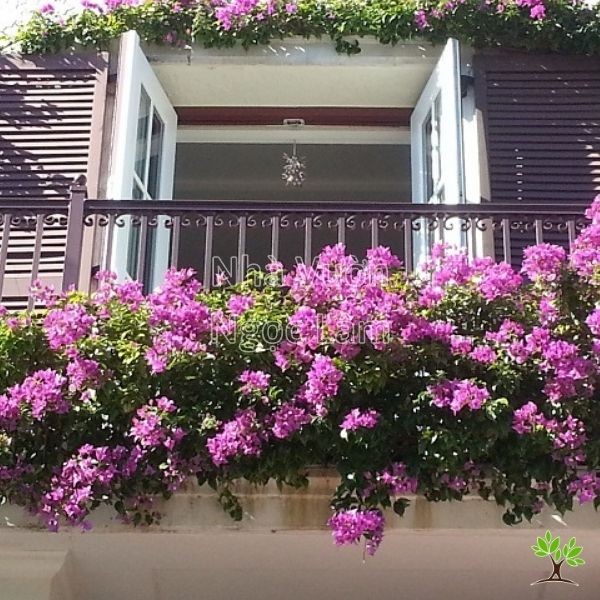 Pink Bougainvillea cascading over a balcony railing
Pink Bougainvillea cascading over a balcony railing
Characteristics: Also known as paper flower, Bougainvillea is a showy, vibrant bloomer frequently used to decorate gates or home entrances. Its name comes from its delicate, papery bracts (often mistaken for petals). Bougainvillea is a vigorous, fast-growing woody vine. It has abundant branches with alternate simple leaves, typically oval-shaped with a pointed tip. While evergreen in many climates, leaves may drop in winter in colder regions. Bougainvillea comes in single and double-flowered varieties. Double-flowered types tend to bloom longer (2-3 months), even holding dried flowers on the plant. Single blooms are often more prolific but fade faster. They offer a wide spectrum of colors, including white, pink, red, orange, and yellow. Grafting allows for stunning multi-colored plants.
Care: Bougainvillea loves full sun and dislikes excessive watering. Overwatering encourages leafy growth at the expense of blooms. To stimulate flowering, allow the soil to dry out between waterings. Some gardeners even induce leaf drop by temporarily withholding water to trigger a massive bloom.
Climbing Rose
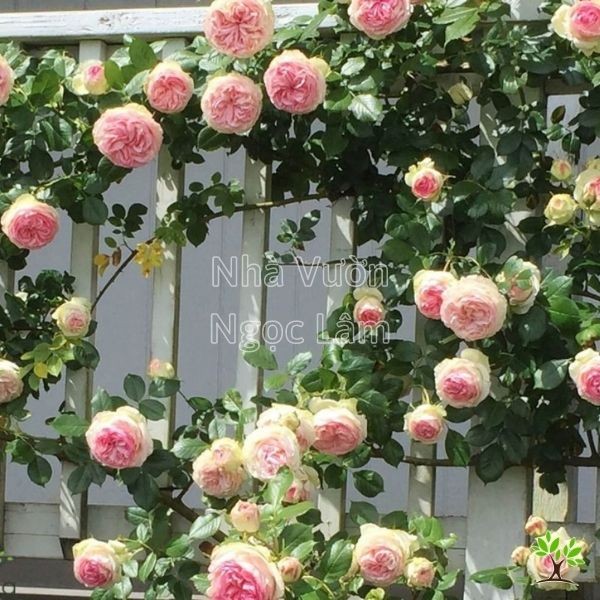 Vibrant pink climbing roses adorning a balcony
Vibrant pink climbing roses adorning a balcony
Characteristics: Climbing roses are very popular for their beauty and fragrance. They come in various sizes, colors, and origins. Many gardeners favor imported varieties for their diverse colors and unique scents. Roses are woody plants that adore sunlight. Providing ample sun exposure is crucial for continuous blooming. If your balcony is shaded or the plant is overshadowed, it might not flower well. While roses can bloom year-round, they often produce their most spectacular display in late autumn and early spring when the weather is cooler. During these periods, plants are healthier, and blooms reach optimal size and intensity.
Care: Climbing roses can be somewhat demanding. They require regular pruning and consistent care; otherwise, they can become susceptible to diseases, cease flowering, and decline.
Aster
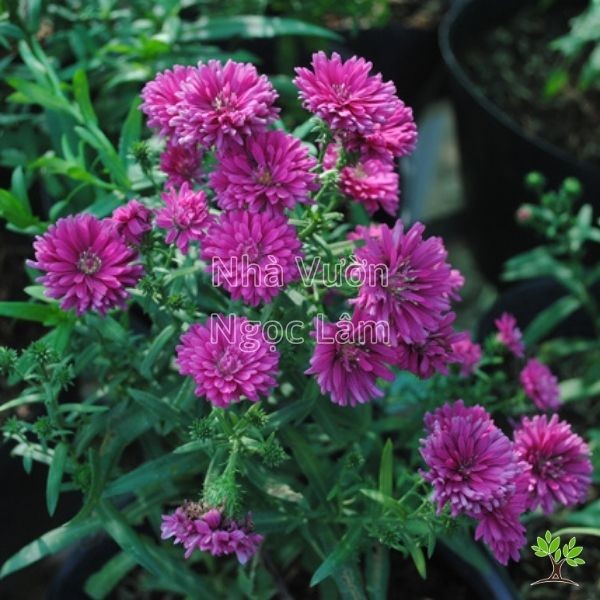 Purple Aster flowers with yellow centers in a pot on a balcony
Purple Aster flowers with yellow centers in a pot on a balcony
Characteristics: Known scientifically as Aster amellus, Asters are native to Europe and belong to the Daisy family (Asteraceae). They are also called European Michaelmas Daisy or occasionally, but less accurately, “forget me not.” Asters are simple yet charming flowers that evoke feelings of nostalgia and peace. They come in beautiful, vibrant colors like pink, blue, purple, and white, with prominent yellow centers surrounded by ray petals. Asters can bloom for a long period and are highly adaptable to various climates, making them an ideal choice for a sun-drenched balcony. They lend a romantic and dreamy, yet unfussy, touch to your balcony space.
Petunia
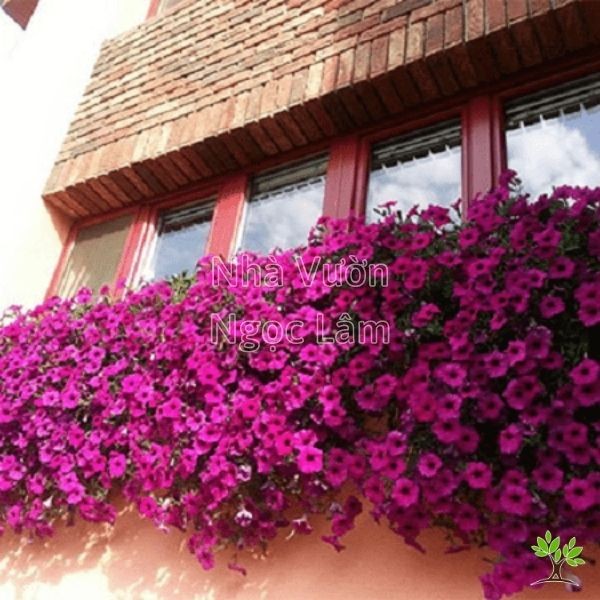 Cascading purple and pink Petunias in hanging baskets on a balcony
Cascading purple and pink Petunias in hanging baskets on a balcony
Characteristics: Petunias are herbaceous plants belonging to the nightshade family (Solanaceae). They are favored for their trailing habit, continuous blooms throughout the year, and distinct fragrance. The stems are soft and cascade gracefully, while the trumpet-shaped flowers feature gently ruffled petals, creating a beautiful display. Vibrant, eye-catching, and long-lasting are terms often used to describe these lovely flowers.
Care: Petunias are among the easiest balcony plants to grow. They love sun, are simple to plant and care for, and varieties are widely available. However, they require consistent watering – not too much to waterlog the soil, but not so little that the soil dries out completely. Neglect can lead to rapid decline. Some care tips: water in the morning and remove withered leaves, which can harbor diseases. Protect them from intense heat (above 35°C/95°F) and heavy rain, as they are sensitive to high temperatures, which can harm the roots. With thin leaves, abundant flowers, and hollow stems, they are highly susceptible to drying out and will quickly perish if they lack water.
Snowflake Flower
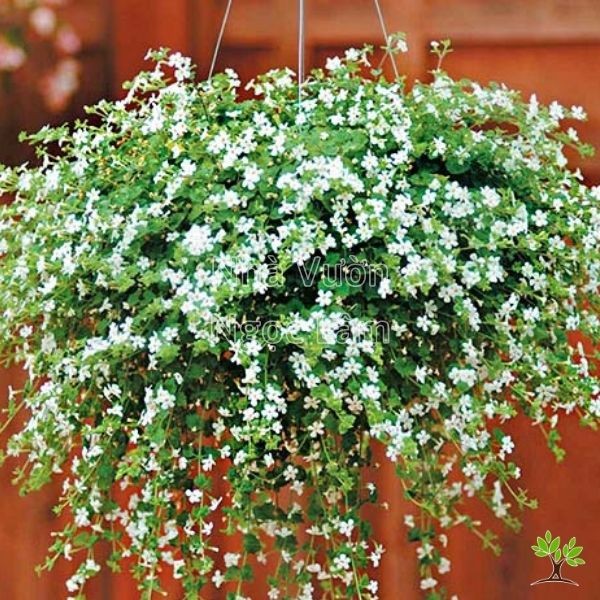 Small white and purple flowers blooming in a pot
Small white and purple flowers blooming in a pot
Characteristics: Snowflake flowers typically feature purple and white blooms with tiny flowers accentuating a backdrop of green leaves, drawing the eye. The flowers have long stems, with the central pistil protected within small, five-petaled blooms, possessing a wild, natural beauty. These plants are suitable for balconies because they are easy to grow and do not demand extensive care.
Periwinkle
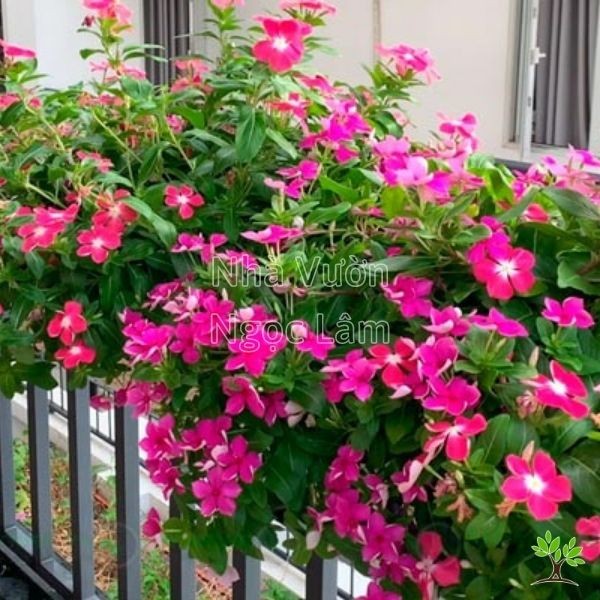 Colorful Periwinkle flowers in various shades
Colorful Periwinkle flowers in various shades
Characteristics: Periwinkle (Catharanthus roseus), also known as Vinca, is an herbaceous plant with two main types: upright and trailing. Upright varieties are often used for bedding or pots, while trailing types are perfect for hanging baskets on balconies. The plant grows about 35-55 cm tall. Periwinkle typically has five petals, often in red or pink, with glossy leaves. Its key advantage is that its flowers are remarkably fresh and long-lasting. This plant blooms profusely year-round, ensuring your home space always looks cheerful and vibrant with attractive colors. Nowadays, cultivated varieties offer even more colors like purple, white, and various shades of pink and red. This makes Periwinkle a popular choice when people seek flowers for their balcony gardens.
Care: Periwinkle is very easy to grow and can flower continuously. It’s well-suited for ground cover or for planting in pots or hanging baskets on balconies. For hanging baskets, choose the trailing type; for standing pots, select the upright variety.
Antigonon (Coral Vine)
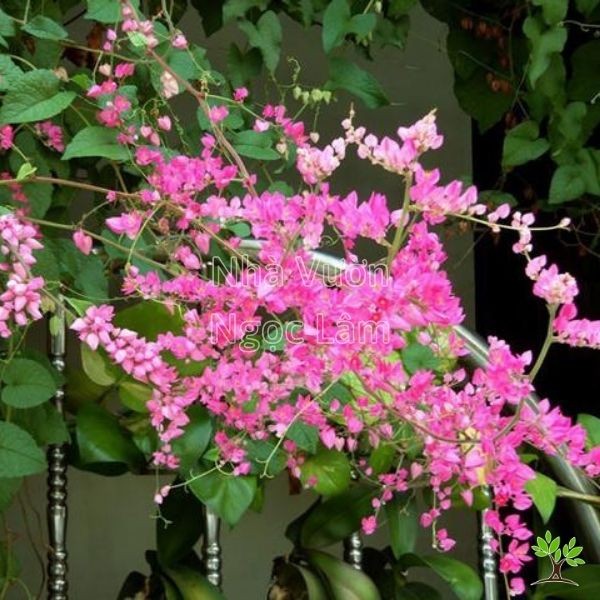 Pink Antigonon flowers climbing on a structure
Pink Antigonon flowers climbing on a structure
Characteristics: Antigonon, scientifically known as Antigonon leptopus, is also commonly called Coral Vine or Queen’s Wreath. Native to Mexico, this plant is a fast-growing vine. Despite its delicate appearance, Coral Vine possesses incredible vitality and vigorous growth. It can grow quite tall, reaching heights of 10-12 meters, clinging using its tendrils. It has simple, alternate leaves, with noticeably heart-shaped blades that are quite unique. The underside of the leaves may have fine hairs. Its flowers typically bloom in clusters of pink to reddish-pink, with each flower having five beautiful petals. Given favorable conditions, Coral Vine can bloom year-round and can produce small, three-angled brown fruits containing seeds.
Care: As a vine, Antigonon thrives in full sun. Place its pot where it can receive plenty of light for optimal growth and flowering. The ideal temperature for Coral Vine is between 18-30°C (64-86°F). This vine prefers humidity, so water it daily for good development. During summer, you might water twice a day, in the early morning or late evening, to prevent the soil from drying out and maintain moisture levels.
Wisteria
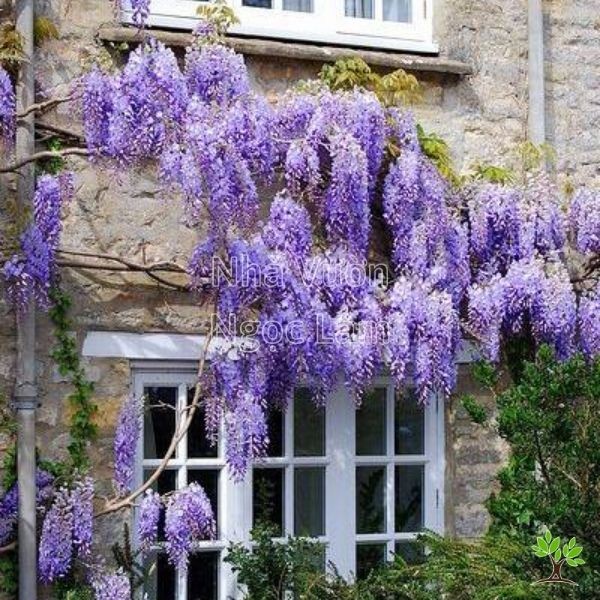 Purple Wisteria blooms cascading from a trellis
Purple Wisteria blooms cascading from a trellis
Characteristics: Wisteria is known by several names, including Purple Bean, Chinese Wisteria, or Japanese Wisteria. It is a woody vine that climbs by twining its stems. Wisteria is a long-lived plant, capable of reaching significant heights (even up to 30m in ideal conditions when not constrained) and spreading widely. Its trunk darkens with age and is pliable when young, becoming thicker and harder as it matures. Leaves are compound, arranged alternately along the stem, soft, thin, with smooth edges. Leaves often drop in late autumn or early winter, after which the plant buds and flowers. Wisteria flowers come in colors like white, pink, purple, and yellow. In some regions, purple is the most common color. Beyond their beautiful form, Wisteria flowers possess a wonderfully pleasant fragrance. The seed pods resemble bean pods.
Care: Wisteria primarily thrives in cool climates and is very cold-hardy. It may struggle to develop well in consistently high temperatures. Wisteria is not particularly fussy about soil and can grow well even in poor soil. However, paying attention during the seedling stage helps ensure good growth. Note: Due to its vigorous growth potential, Wisteria requires strong support and diligent pruning to be managed in a container on a balcony.
Geranium
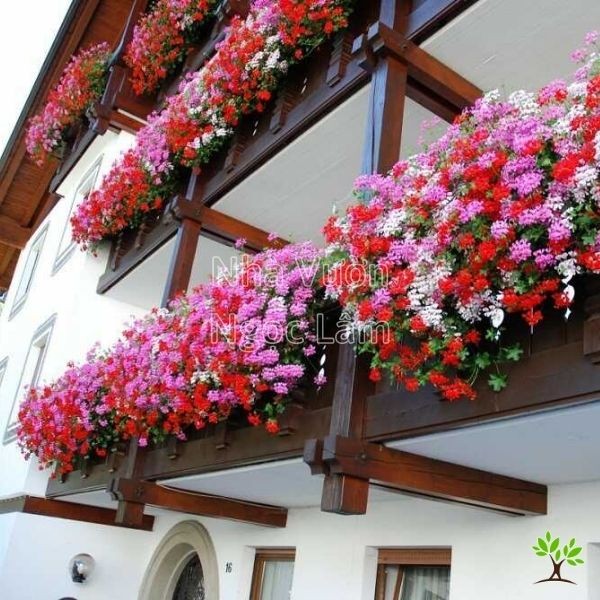 Bright red Geranium flowers in pots
Bright red Geranium flowers in pots
Characteristics: Geraniums come in upright and trailing varieties, with trailing types being very popular for balcony containers and hanging baskets. These flowers are available in numerous colors, including red and pink.
Care: Geraniums can grow well in various light conditions, from full sun to partial shade. They bloom profusely from winter through summer, with each flowering period lasting around two weeks. These plants do not require excessive watering; 1-2 times per day is usually sufficient. However, if you notice significant leaf drop, it indicates the plant is thirsty and needs immediate watering. For abundant blooms, fertilize every 2-4 weeks.
Golden Shower Vine
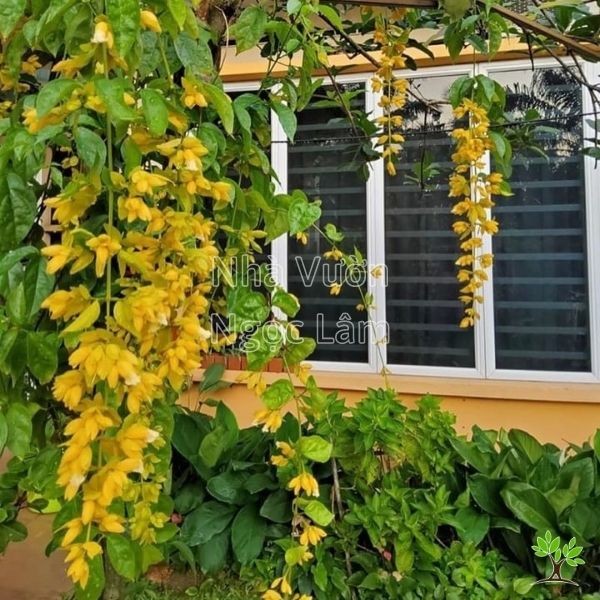 Yellow Golden Shower Vine flowers cascading
Yellow Golden Shower Vine flowers cascading
Characteristics: Golden Shower Vine, scientifically known as Petraeovitex bambusetorum, is native to Southeast Asia. It is a trailing vine, typically growing to a height of about 50-250 cm. Its leaves are oval-shaped, slightly pointed at the tip, dark green, and glossy, somewhat resembling the leaves of some other common vines. Golden Shower Vine is incredibly floriferous, with flowers often emerging from the leaf axils. The blooms form impressive cascading chains of bright yellow flowers, making them very eye-catching. The soft stems, leaves, and long, flowing flower chains combine with the bright yellow color to give Golden Shower Vine a special and prominent allure. The flower chains are very long-lasting, often blooming from autumn through spring each year.
Care: Originating from the tropics, this plant grows vigorously in warm climates. It is very easy to grow and care for, healthy, resistant to pests and diseases, and tolerates difficult weather conditions quite well. Golden Shower Vine prefers full sun; the more sun it receives, the more abundant and intensely colored its flowers will be.
Rangoon Creeper
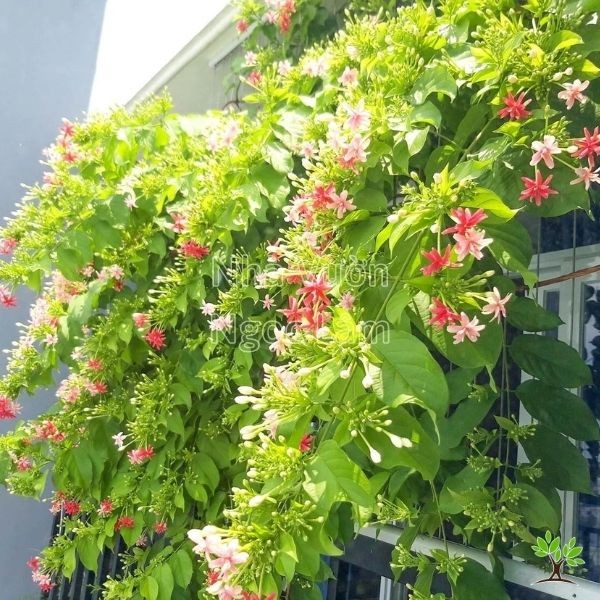 Clusters of pink and red Rangoon Creeper flowers
Clusters of pink and red Rangoon Creeper flowers
Characteristics: Rangoon Creeper (Combretum indicum) is native to tropical Asia and Africa and is commonly found in many tropical regions. It is also known as Chinese honeysuckle or Burma creeper. This plant is a woody vine. The name “Rangoon Creeper” often symbolizes resilience and perseverance, reaching towards light and truth with abundant strength despite challenging conditions. It is a plant that remains lush green year-round and produces beautiful, lightly fragrant flowers that are popular for gardens, fences, and trellises, or used to create shady arbors. The plant’s fruit has also been traditionally used in medicine. It is highly sun-tolerant, stays green throughout the year, and typically blooms most vibrantly in summer. Its flowers form beautiful clusters of red.
Care: Caring for Rangoon Creeper is quite easy. You simply need to water the plant and occasionally fertilize it to provide nutrients. When watering, give it slightly more water than other plant types, but avoid waterlogging as Rangoon Creeper is not tolerant of soggy conditions. It is also less prone to pests and diseases.
Morning Glory
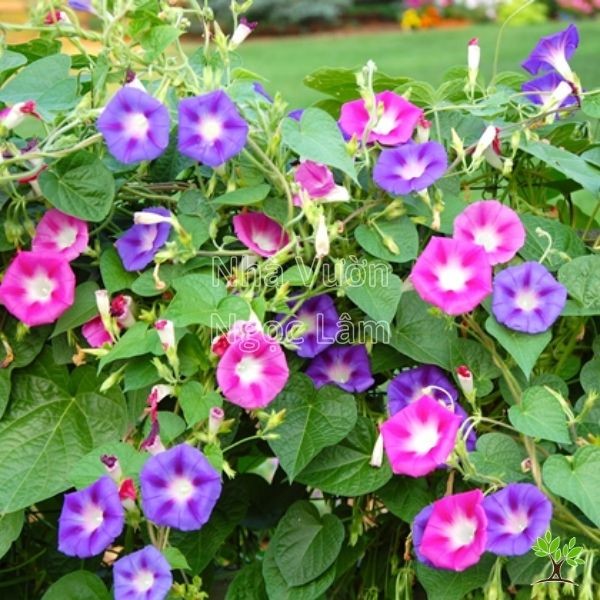 Purple Morning Glory flowers climbing a fence
Purple Morning Glory flowers climbing a fence
Characteristics: Morning Glory, also known as Ipomoea or Asagao (in Japanese), is easy to care for and plant, and is highly favored in Japan for home decoration. The flowers are funnel-shaped, about 5 cm wide, with white throats. The flower stems emerge from leaf axils and are quite short. Morning Glory vines come in various colors, including purple, blue, bright red, or white. Notably, Morning Glory blooms are most beautiful in the sunny mornings, when they appear particularly radiant and bright.
Care: Morning Glory is a sun-loving plant that can also tolerate partial shade, but it requires plenty of light throughout its growth period. Therefore, you can plant it along a fence, near the entrance, or on a terrace to ensure they receive ample sunlight.
Mandevilla
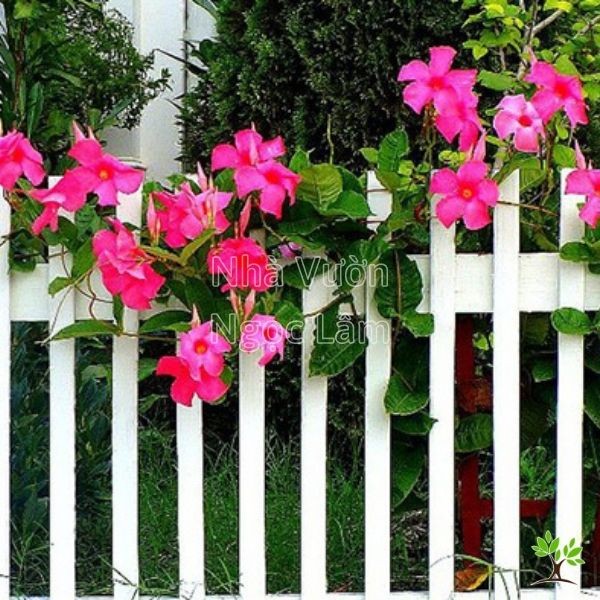 Pink Mandevilla flowers blooming in a pot
Pink Mandevilla flowers blooming in a pot
Characteristics: Mandevilla is a vine that can climb on trellises or other supports, potentially reaching heights of 4.5 meters in favorable warm climates. This evergreen plant has herbaceous stems when young, which are greenish-pink, slightly hairy, and pliable, making them easy to train on a trellis. As they mature, the stems become thicker, woody, and gray. Mandevilla leaves are typically about 6 cm long and 3-5 cm wide. The large, tubular flowers are pink, ranging from pale to deep shades. Other varieties come in red or white with yellow centers.
Care: Mandevilla prefers sun but can tolerate partial shade. While it can be placed in a shadier spot, insufficient light will result in fewer blooms. This plant thrives in warm, humid climates with ample light. The optimal growing temperature is between 20-30°C (68-86°F). Mandevilla prefers well-draining, humus-rich soil. Be sure to keep the soil consistently moist but never waterlogged. A common issue is mealybugs, which suck plant sap. If you observe curled leaves, wilting flowers, and small white spots, the plant is likely infested. Treat with an insecticide, preferably spraying on sunny days for better effectiveness. Regularly remove dead leaves from the base of the plant to prevent moisture buildup and fungal diseases. Prune thin or weak shoots to encourage healthier new growth. You can also help prevent mealybugs by using ant killer around the base, as ants can transport mealybug eggs.
Begonia
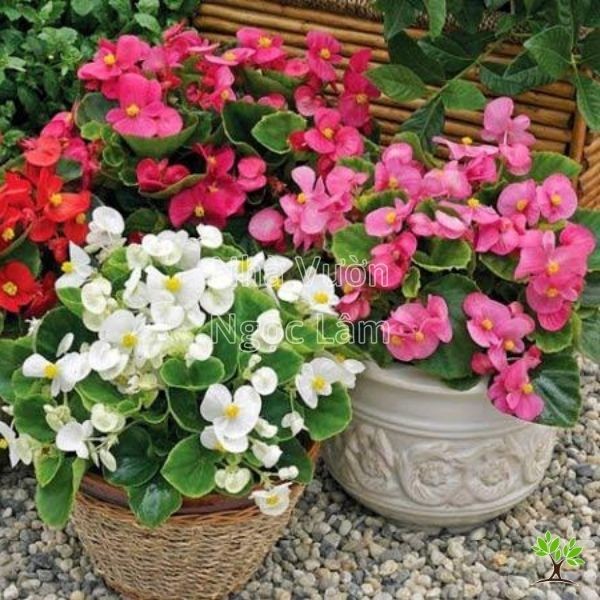 Begonia flowers with spotted leaves in a pot
Begonia flowers with spotted leaves in a pot
Begonias are plants that live and grow year-round. Their flowers cascade gracefully, adding a romantic and charming touch to the balcony. Begonia leaves are often spotted or patterned and come in various shapes and colors. Importantly, Begonias require consistent moisture and adequate watering. This plant prefers partial shade; full sun can scorch its leaves and hinder photosynthesis. Therefore, place your Begonia in a location with good air circulation and protection from direct sun and heavy rain.
Million Bells
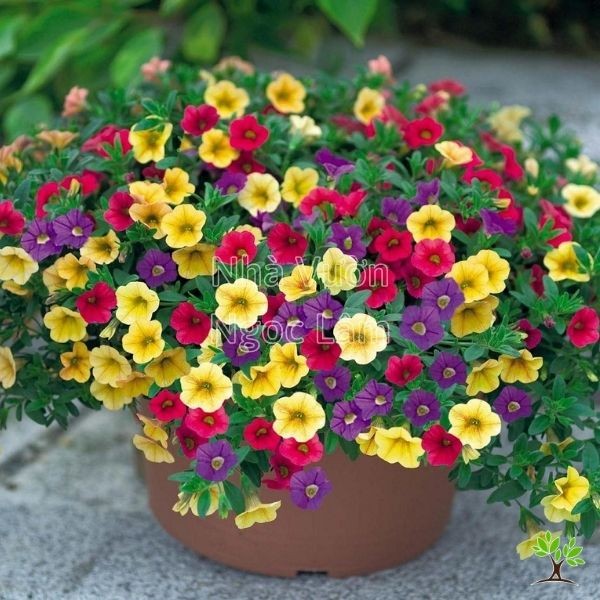 Numerous colorful Million Bells flowers in a hanging basket
Numerous colorful Million Bells flowers in a hanging basket
Characteristics: True to its name, Million Bells (Calibrachoa parviflora), native to South America, decorates your balcony with thousands of cheerful, bell-shaped blooms. These flowers come in an incredibly diverse range of colors, including white, purple, pink, yellow, orange, and red. Their small, cute appearance resembles tiny bells. With their vibrant beauty and robust growth, thriving even in challenging weather, Million Bells truly deserve the title of “queen of sun-loving flowers.” The best time to start growing them is in spring and autumn, as the plants will develop fastest and be less susceptible to pests and diseases.
General Care Tips for Balcony Flowers
- Watering: Provide appropriate watering for each plant type, avoiding excess water that could spill or damage your balcony floor.
- Fertilizing: Fertilize regularly to ensure plants remain healthy and green, enhancing the aesthetic appeal of your home.
- Pruning: Promptly remove yellow or withered leaves to prevent harm to the plant and surrounding greenery.
- Cleaning: Balconies can accumulate dust, so frequently wipe the leaves of your plants clean.
Adding plants to your balcony is a wonderful way to bring nature closer and create a beautiful, relaxing space. Choosing the right flowers and giving them consistent care will reward you with vibrant blooms and a refreshing environment.
Explore the possibilities for your own green retreat and find the perfect plants to transform your balcony into a flourishing haven.



